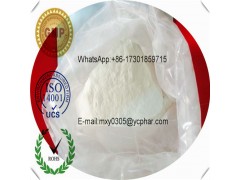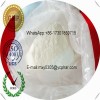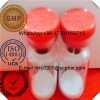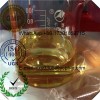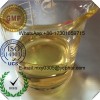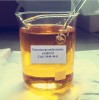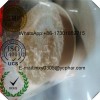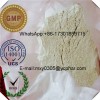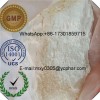Griseofulvin
Basic information:
Product Name: (+)-Griseofulvin
Synonyms: (+)-GRISEOFULVIN;GRISEOFULVIN;[2S-TRANS]-7-CHLORO-2,4,6-TRIMETHOXY-6'-METHYLSPIRO[BENZOFURAN-2(3H), 1'(2)-CYCLOHEXANE]-3,4'-DIONE;(2S)-TRANS-7-CHLORO-2',4,6-TRIMETHOXY-6'-METHYLSPIRO(BENZOFURAN-2[3H],1'-[2]CYCLOHEXENE)-3,4'-DIONE;7-CHLORO-2',4,6-TRIMETHOXY-6'-METHYL-, (1'S-TRANS)-SPIRO(BENZOFURAN-2(3H),1'-(2)CYCLOHEXENE)-3,4'-DIONE;(+)-griseofulvi;(2s-trans)-7-chloro-2’,4,6-trimethoxy-6’-methylspiro[benzofuran-2(3h),1’-[2]cy;(2s-trans)-xy-6’-methyl
CAS: 126-07-8
MF: C17H17ClO6
MW: 352.77
EINECS: 204-767-4
Product Categories: Intermediates & Fine Chemicals;Pharmaceuticals;Antifungal;Aromatics;Chiral Reagents;VERELAN;Inhibitors
Mol File: 126-07-8.mol
Chemical Properties:
MP 218-220 °C(lit.)
alpha 354 º (c=1, dimethylform)
storage temp. −20°C
Water Solubility practically insoluble
Merck 14,4549
BRN 95226
Griseofulvin pure product is colorless crystal, being neutral, and insoluble in water with a strong systemic property. It is stable both in vitro and in vivo of plants and is also stable to the various environment factors between pH3.0 ~ 8.8. It can be used for prevention and treatment of a variety of fungal plant diseases. The main species china applied for production of griseofulvin is Penicillium nigricans and Penicillium urticae. When grown at the medium, Penicillium nigricans is fuzzy with fresh culture being pure gray and aging culture being dark gray with its back being deep orange-red to the back orange brown. The fungi lawn of Penicillium urticae is yellowish green to pure light gray, thick and dense with the back being pale yellow to brownish; their aerial hyphae has a broom-like shape.
Safety Information :
Hazard Codes T,Xn
Risk Statements 60-61-40-43-45
Safety Statements 53-22-36/37/39-45
WGK Germany 3
RTECS WG9800000
Hazardous Substances Data 126-07-8(Hazardous Substances Data)
General description:
Griseofulvin is a non-polyene class antifungal antibiotics; it can strongly inhibit the mitosis of fungal cell and interfere with the fungal DNA synthesis; it can also bind to tubulin to prevent fungal cell division. It has been applied to clinical medicine since 1958 and has currently been widely used for treating the fungal infections of the skin and the stratum corneum with strong inhibitory effects on Trichophyton rubrum and Trichophyton tonsorans, etc. Griseofulvin is not only a widely used antibiotic for clinical treatment of fungal infections of the skin and cuticle, but also applied in agriculture for prevention and treatment of fungal diseases; for example, it has a special efficacy on treating a kind of candidiasis in apple which can cause infection during pollination.
Usage And Synthesis:
Usage :
In medicine, this product mainly has good antibacterial effect against Trichophyton, Microspores, and Epidermophyton fungi. However, it has no anti-bacterial effect on Candida, Cryptococcus, Histoplasma, Sporothrix, Blastomyces, and Coccidioides and so on. Mechanism of action of is drug is through interfering with the biosynthesis of nucleic acids of fungal and further inhibiting of its growth.
In agriculture, this product has good inhibitory effect on the Ascomycetes, Basidiomycetes, Deuteromycetes and some kinds of algae. However, it is not effective in treating oomycetes whose cell wall containing no chitin content. After spraying melons and other crops, it can be transferred into the branch, leaves and fruits through inner absorption, the absorption of water via rrot, as well as transpiration effect, and further preventing the fungal diseases; according to the study of Brandeis et al. (1946), at a concentration as low as even 10 mg/L or 1 mg/L, griseofulvin can already can make the mycelium of Bctrytis allill be stout, deformed and exhibit spiral bending, also cause: large number of abnormal branching; the development retardation of germinated spores, and loss of apical dominance; thus it has uptake therapeutic effects on a variety of plant diseases, especially powdery mildew, gray mold diseases; Griseofulvin has a more prominent antibacterial activity than the bactericidal activity.
Indications:
1.In medicine
this product is suitable for the treatment of a variety of ringworm, including tinea capitis, tinea barbae, body tinea, jock itch, foot tinea and onychomycosis. The various kinds of tinea mentioned are caused by various fungi including Trichophyton rubrum, Trichophyton tonsorans, Trichophyton mentagrophytes, Fingers Trichophyton, etc., and Microsporon audouini, Microsporon canis, Microsporon gypseum and Epidermophyton floccosum, etc. due. This product is not suitable for treatment in mild cases, localized infection cases and cases which can be treated with topical antifungal agents. Griseofulvin is not effective in treating the infections of a various kinds of fungi such as Candida, Histoplasma, Actinomyces, Sporothrix species, Blastomyces, Coccidioides, Nocardio and Cryptococcus species as well as treating tinea versicolor.
2.In agriculture,
This product is first introduced by Brian et al (1951) for control of plant diseases. According to previous studies, it can be used for prevention of melon (melon) vine blight, crack spread disease, watermelon blight, anthracnose, apple blossom rot, apple cold rot, apple rot, cucumber downy mildew , strawberry gray mold, gourds hanging blight, powdery mildew of roses, chrysanthemums powdery mildew, rot flower lettuce, early tomato blight, tulip fire blight and other fungal diseases.
Adverse reactions:
1. Nervous system headache is relatively common with about 10% of patients experiencing headaches; it is a bit severe at initial stage, but will be alleviated with the continuing administration of drug; other reactions also include lethargy and fatigue. Occasional dizziness, ataxia, and peripheral neuritis may also occur.
2. For Digestive system; a small number of patients may undergo abdominal discomfort, nausea or diarrhea, usually mild which can be tolerated by the patient.
3. Allergies can occur in about 3% of patients which suffers rash; occasionally angioneurotic edema, persistent urticaria, and exfoliative dermatitis can also occur; in very rare cases, photosensitive dermatitis can occur at a small number of patients.
4. This product can sometimes cause reduction of the number of peripheral blood leukocyte; sometime can even cause liver toxicity and proteinuria.
Order Details:
Payment Methods:West unio,Moeny Gram and Bank Transfer
Delivery Ways:EMS,HKEMS,TNT,DHL,FedEX,UPS etc
Shipment Time:Within 8 hours after confirmation of your payment
Other Service:Safe shipment,high purity and best price for you
Featured Service:
Price:reasonable and favorable
Package:discreet and disguised.Detailed things can be discussed via email
Shipment methods:we can take different shipment ways for different countries
Other Service:parcel picture,tracking number and tracking website can be offered after shipment
Customs Rate:99.5% successful rate.if seized,our company will offer you re-shipment policy

